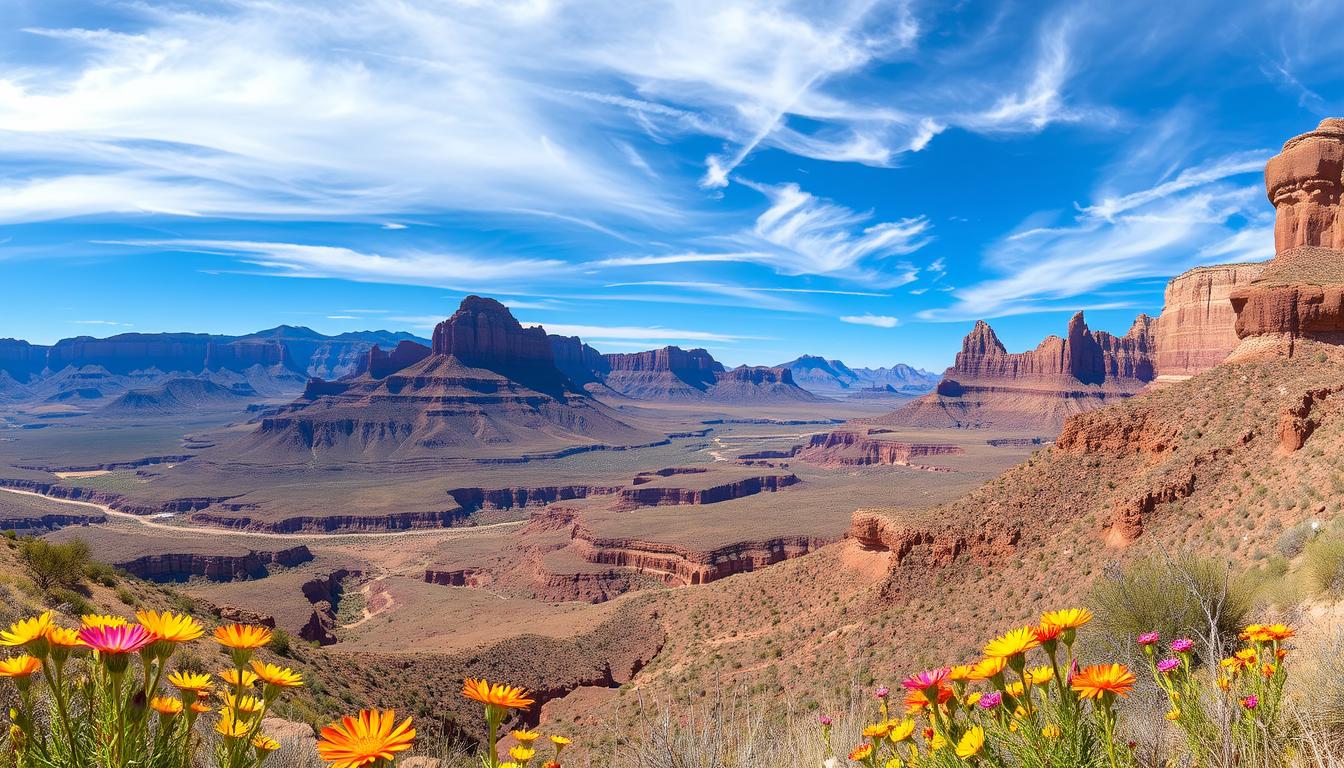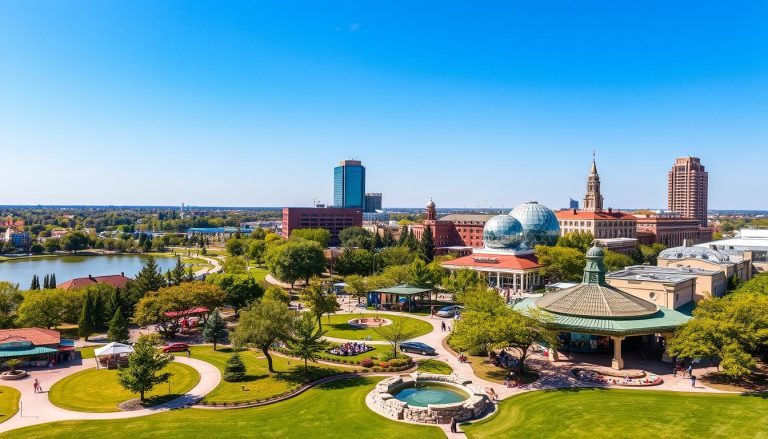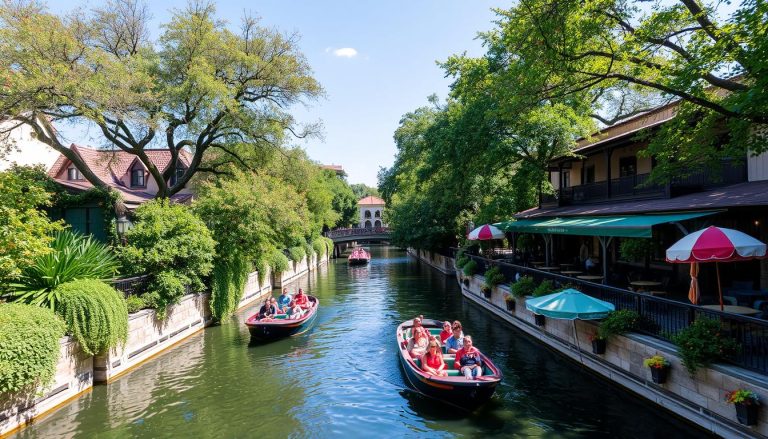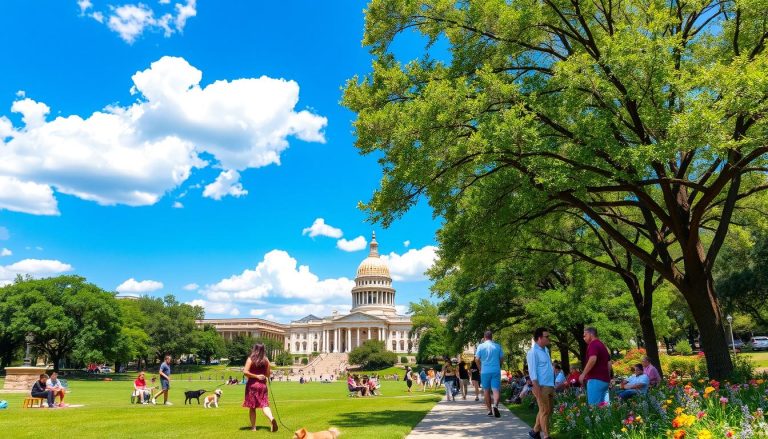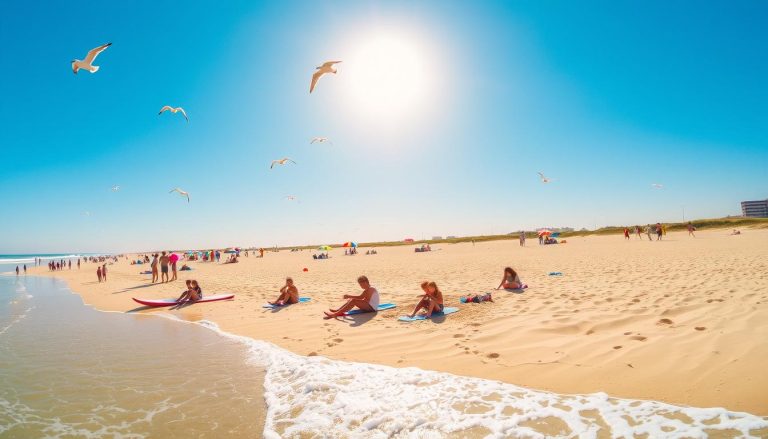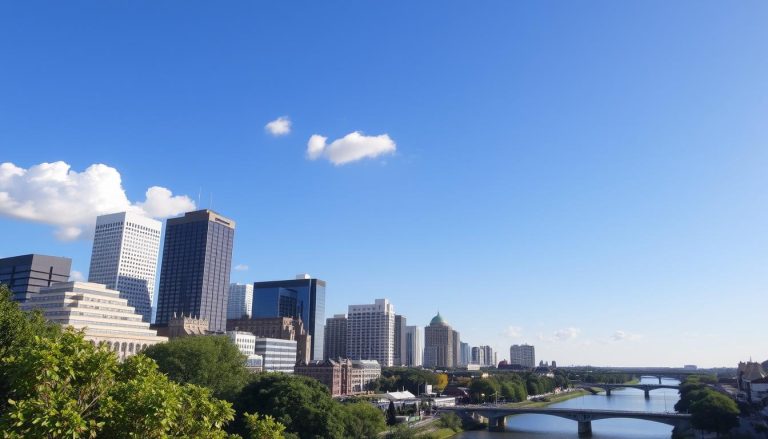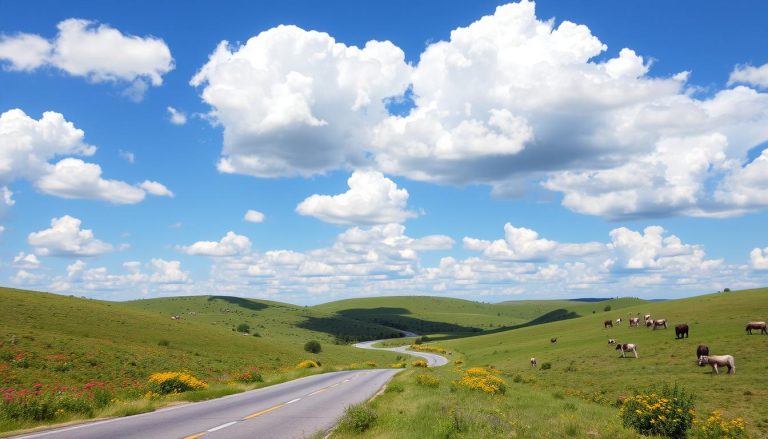Ever dreamed of exploring a vast, remote desert in the American Southwest? Welcome to Big Bend National Park, a true gem in West Texas. It spans over 800,000 acres, offering outdoor adventures, stunning beauty, and rich culture.
But what makes Big Bend special? What hidden gems and must-do activities await the intrepid traveler in this remarkable corner of Texas? From hiking the Chisos Mountains to kayaking the Rio Grande, this article will guide you through the top things to see and do in this unique national park.
Key Takeaways
- Big Bend National Park covers over 800,000 acres of diverse landscapes in West Texas.
- It offers a range of outdoor activities, including hiking, camping, wildlife viewing, and river adventures.
- The park is known for its stunning Chihuahuan Desert, Chisos Mountains, and the Rio Grande River.
- Established in 1944, Big Bend is a remote and unique destination along the USA-Mexico border.
- Visitors can explore the park’s four established campgrounds and nearby towns for lodging options.
Introduction to Big Bend National Park
Big Bend National Park is a hidden gem in the Chihuahuan Desert of West Texas. It was created in 1944 and spans over 801,163 acres. This vast area is one of the largest national parks in the lower 48 states. It’s surrounded by the Rio Grande and the Chisos Mountains, offering a unique experience in the Texas wilderness.
Overview of Park's Location and Significance
Big Bend National Park is in a very diverse area. The Chihuahuan Desert, the Rio Grande, and the Chisos Mountains all meet here. It’s a favorite spot for those who love the outdoors, nature, and seeking a true wilderness adventure. The park is known for its rich biodiversity, geological wonders, and cultural heritage.
Brief History and Park Establishment
The story of Big Bend National Park began in the early 20th century. It was recognized for its unique natural and cultural treasures. After years of advocacy, it was established in 1944, becoming the 24th national park. Since then, it has welcomed visitors from all over, offering a chance to experience the Chihuahuan Desert and the Rio Grande.
Park Size and Geographic Features
Big Bend National Park is one of the largest in the contiguous United States. It covers 801,163 acres with diverse landscapes. You’ll find the Chisos Mountains, the Rio Grande, and the Chihuahuan Desert. This mix of ecosystems and natural beauty makes it a standout destination for outdoor lovers and nature enthusiasts.
| Location | Size | Key Geographic Features |
|---|---|---|
| West Texas, bordering Mexico | 801,163 acres | Chihuahuan Desert, Rio Grande, Chisos Mountains |

“Big Bend National Park is one of the most remote and least visited national parks in the United States, offering visitors a unique wilderness experience.”
Planning Your Visit to Big Bend
Planning a trip to Big Bend National Park in Texas is exciting. Start at the Panther Junction Visitor Center. There, you can pay the $30 entrance fee and get all the info you need.
Make sure to get permits for the Rio Grande or backcountry camping. Use the Official National Park Handbook and trail guides. They have all the park’s rules, facilities, and attractions.
- Check the weather, river, and road conditions before you go. This ensures a safe and fun trip.
- Bring enough supplies like fuel, food, and water. The park’s facilities are limited, so be self-sufficient.
Planning your visit to Big Bend National Park is key to enjoying it fully. With the right info and prep, you’re set for an amazing adventure.
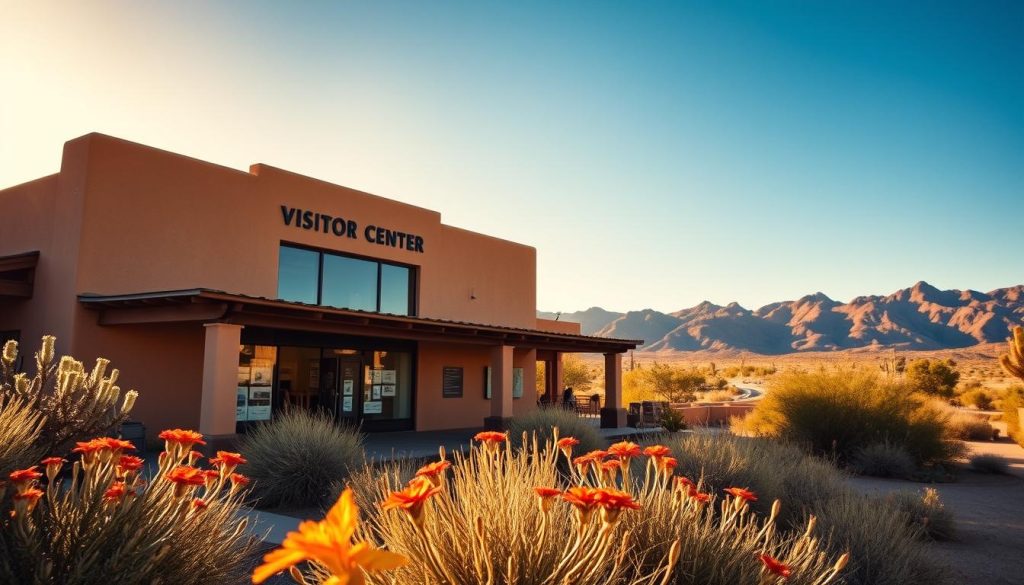
“The beauty of the landscape is so subtle and so powerful that it’s almost overwhelming. It’s the kind of place that gets under your skin and stays with you long after you’ve left.”
Best Time to Visit Big Bend National Park
Timing your visit to Big Bend National Park in Texas is key. The park’s varied landscapes and weather patterns offer something special all year. Each season has its own perks.
Seasonal Weather Patterns
Big Bend’s weather changes a lot with the seasons. In spring, the weather is mild, with temperatures in the 70s to 80s Fahrenheit. This makes hiking and exploring enjoyable.
The summer months are very hot, with temperatures often over 100°F on the desert floor. The fall and winter seasons have milder temperatures. But, nights can get cold, below freezing.
Peak and Off-Peak Seasons
- Spring, especially March, is the busiest time. People love the mild weather and spring wildflowers.
- The summer heat keeps many away, making it a quiet time. But, the higher areas are cooler.
- The winter months are less crowded. It’s peaceful, but snow can make some areas hard to reach.
Special Events and Activities by Season
Big Bend National Park has special events all year. In spring, the Wildflower Festival celebrates the flowers. Summer brings ranger-led programs and stargazing.
In fall and winter, there are guided hikes and wildlife viewing. You can also enjoy winter activities.
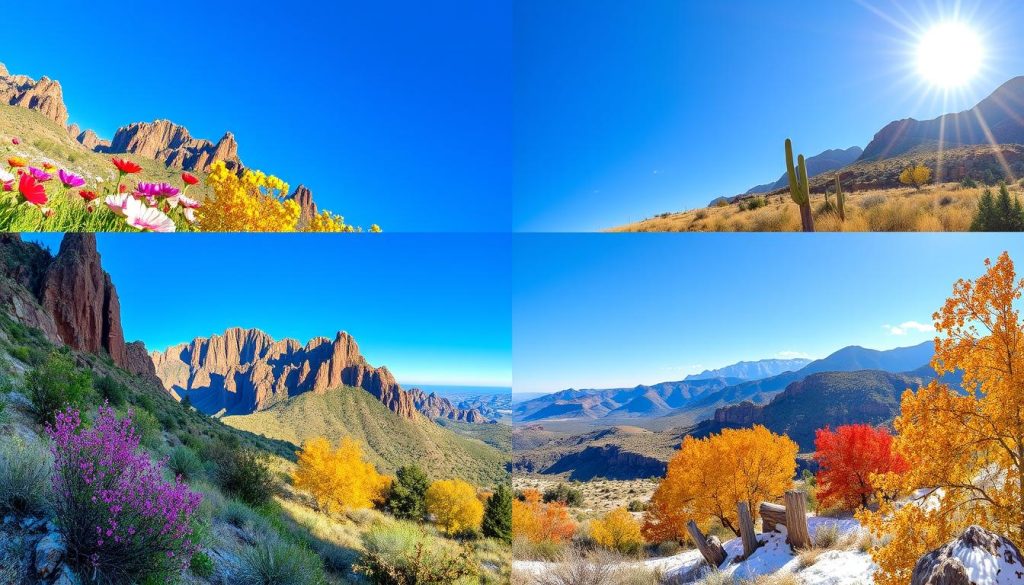
“The best time to visit Big Bend National Park really depends on your interests and preferences. Each season has its own unique charm and experiences to offer.”
Getting to Big Bend National Park
Getting to Big Bend National Park is a journey, but it’s worth it. The park is in the remote southwestern corner of Texas. It’s about 4.5 hours from El Paso, the nearest big city. Since public transport is scarce, driving is key for your trip.
The nearest airports are El Paso International Airport and Midland/Odessa International Airport. El Paso has more flights and car rentals, making it easier to get there. Midland/Odessa has fewer flights and might cost more for rentals.
After landing, start your drive. Get supplies in Alpine or Fort Stockton before you enter the park. Gas stations and shops are few inside the park. Remember, cell phone signals are weak, so enjoy the quiet of this wild place.
Transportation Options and Driving Directions
- Fly into El Paso International Airport or Midland/Odessa International Airport for the nearest major airports
- Rent a car to explore the park and surrounding areas – driving is essential as public transportation is limited
- Stock up on supplies in Alpine or Fort Stockton before entering the park, as amenities can be limited
- Be prepared for long distances between towns and limited cell phone coverage within the park
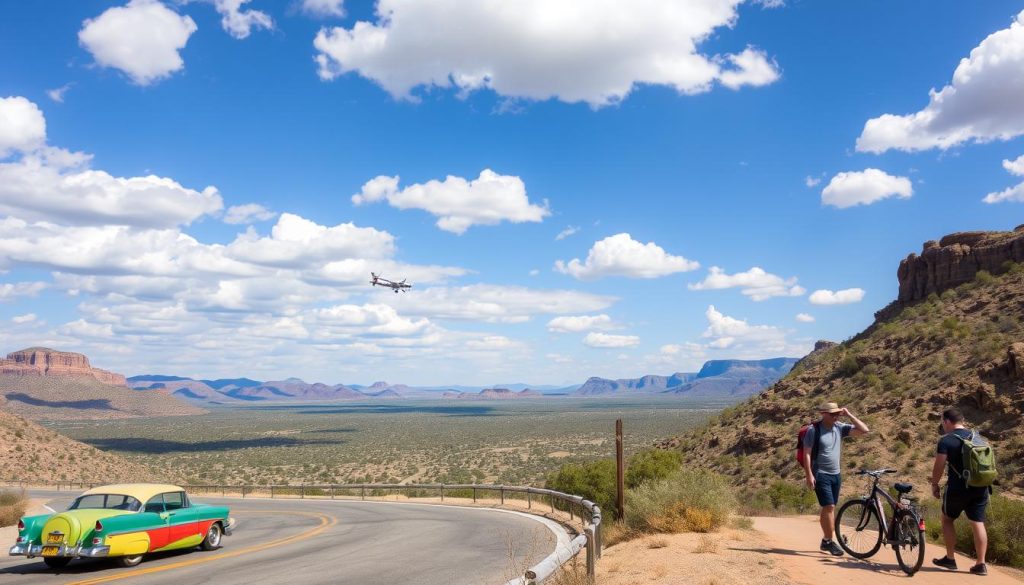
“Big Bend is one of the most remote and rugged national parks in the United States, so getting there requires some planning and preparation. But the stunning landscapes and unique experiences make it a truly unforgettable destination.”
Park Regions and Layout
Big Bend National Park is in the remote West Texas. It covers over 800,000 acres. The park has three main areas, each with its own charm.
Chisos Mountains Area
The Chisos Mountains are at the park’s heart. They reach up to 7,800 feet. This mountainous region is cooler than the desert landscapes around it.
Hiking trails in the Chisos Basin offer scenic views. You might see black bears and Mexican spotted owls.
Rio Grande Village
The Rio Grande Village is by the Rio Grande. It’s the border between Texas and Mexico. Here, you can visit the park’s hot springs.
The hot springs flow at 250,000 gallons a day. They stay at 105°F. You can also explore the desert landscapes and enjoy scenic drives.
Santa Elena Canyon Region
The Santa Elena Canyon is on the park’s western edge. It has 1,500-foot limestone walls. A 1.7-mile hike takes you to the canyon’s entrance.
There, you see the Rio Grande in the desert landscapes. This area is great for scenic drives and exploring the Chihuahuan Desert.
“Big Bend National Park is a hidden gem in the American Southwest. It offers a unique mix of park geography, desert landscapes, and scenic drives that will amaze any visitor.”
Big Bend National Park, Texas: Best Things to Do - Top Picks
Big Bend National Park is in southwestern Texas. It’s full of outdoor adventures and natural wonders. The park has the Chisos Mountains and the Rio Grande, perfect for nature lovers and adventurers. Let’s look at the top attractions and sights that make it a Texas gem.
The Chisos Mountains Basin is great for alpine views and wildlife. It has hiking trails through greenery with views of peaks. You might see black bears, mountain lions, and Mexican spotted owls.
The Hot Springs are another highlight. Here, you can soak in natural pools by the river. It’s a peaceful spot to relax and enjoy the park’s beauty.
Santa Elena Canyon is a sight to see. Its limestone walls are up to 1,500 feet tall. You can hike or canoe down the Rio Grande for a deep experience.
Boquillas Canyon is near the Rio Grande Village. It has river views and a chance to see the Mexican village of Boquillas del Carmen. Crossing the border to meet locals is a unique experience.
The Lost Mine Trail offers views of the Chisos Mountains. The Ross Maxwell Scenic Drive also shows off the park’s beauty. Both are must-do activities.
The Fossil Discovery Exhibit is for history buffs. It lets you explore the park’s ancient past. You’ll learn about the fossils that shaped this landscape.
“Big Bend National Park is a place of solitude, silence, and solace. It’s a destination that allows you to disconnect from the hustle and bustle of everyday life and reconnect with the natural world.”
Hiking Trails and Scenic Walks
Big Bend National Park in Texas is a dream spot for hikers. It has many trails that show off the park’s varied landscapes. You can find easy walks or tough treks to see the park’s wonders.
The Lost Mine Trail is a favorite, with 5.1 miles of stunning views. It’s a moderate hike that takes 2.5 to 3.5 hours. Don’t miss the Window Trail, a 5.6-mile hike with great views, taking 3 to 4 hours.
For a quick walk, try the Window View Trail, a 0.3-mile stroll that’s done in 20 minutes. The Chisos Basin Loop is 1.8 miles and takes 1 to 2 hours, with easy to moderate difficulty.
For a big challenge, tackle the Emory Peak or South Rim Trail. Emory Peak is a tough 10.4-mile hike with 2,440 feet of climb, taking 5 to 7 hours. The South Rim Trail is even harder, with 12.6 miles and 2,800 feet of gain, needing 6 to 8 hours.
Big Bend National Park has trails for everyone. Explore the Chisos Mountains, Rio Grande Village, or Santa Elena Canyon Region for amazing views and unique rocks. Always carry water, sun protection, and watch out for wildlife like bears and mountain lions.
With over 150 miles of trails, Big Bend National Park is perfect for outdoor lovers. Whether you’re an experienced hiker or just starting out, this Texas park will amaze you.
Accommodation Options
Big Bend National Park has many places to stay, fitting all budgets and tastes. The Chisos Mountains Lodge is inside the park. It has cozy rooms and is close to the Chisos Basin area.
Camping Facilities
For a wilder adventure, the park has several campgrounds. Chisos Basin, Rio Grande Village, and Cottonwood are some of them. Rio Grande Village also has an RV park with full hookups.
To camp in the backcountry, you need a permit. Get it at the park’s visitor centers.
Nearby Towns Lodging
Staying outside the park is also an option. Terlingua, Study Butte, and Lajitas have many places to stay. Terlingua Nights Cabins offer a glamping experience.
The Lajitas Golf Resort is a luxury spot close to the park. These places are great for exploring Big Bend and the area around it.
